Influence of Pollen on Solar Photovoltaic Energy: Literature Review and Experimental Testing with Pollen
Abstract
1. Introduction
2. Soiling-Related Pollen Topics
- Pollen blooms are seasonal events, typically occurring during springtime.
- The beginning, intensity, and duration of the main pollen season, in which most pollen blooms happen, vary from year to year.
- The airborne pollen levels depend on the local vegetation, the local meteorology, and the time of the year.
- Soiling by pollen is a local-scale phenomenon.
- The soiling potential of pollen differs among the vegetal families, genres, and species.
- Anemophilous species, and particularly anemophilous trees, are prone to cause soiling by pollen.
- Local soiling by pollen could be predicted and/or estimated.
2.1. Pollination Strategies
2.2. Pollen Particle Size
2.3. Pollen Aggregation and Disaggregation
2.4. Pollen Fragmentation
2.5. Pollen Hygroscopicity
2.6. Pollen Surface Chemistry
2.7. Pollen Adhesion Forces
2.8. Pollen Dispersal Curves
2.9. Airborne Pollen Monitoring
3. The Influence of Soiling on Photovoltaic Energy
3.1. Soiling by Pollen on PV Modules: A Review
3.2. Experimental Assessment of PV Soiling Losses
4. Artificial Soiling Test with Pollen
4.1. Methodology
4.2. Results
5. Conclusions
Author Contributions
Funding
Conflicts of Interest
Abbreviations, Acronyms and Nomenclature
| A | area of a glass coupon; |
| Aclean | absorbance of a clean glass coupon; |
| APOLLEN | absorbance of pollen; |
| Asoiled | absorbance of a soiled glass coupon; |
| AOD | Aerosol Optical Depth; |
| API | Annual Pollen Index; |
| APIn | Annual Pollen Integral; |
| C. | genera Cupressus; |
| CdTe | cadmium telluride; |
| Cfb | temperate fully-humid climate with warm summer; |
| CIGS | copper indium gallium diselenide; |
| Csa | temperate climate with hot-dry summer; |
| EDS | electrodynamic screen; |
| GPOA | irradiance in the plane of the array; |
| H | height of pollen release; |
| ISC | short-circuit current; |
| ISC,clean | short-circuit current of a clean photovoltaic module; |
| ISC,soiled | short-circuit current of a soiled photovoltaic module; |
| ISC,STC | short-circuit current under standard test conditions; |
| mc-Si | multicrystalline silicon; |
| PDU | pollen dispersal unit; |
| PM2.5 | suspended particulate matter below 2.5 μm in diameter; |
| PM10 | suspended particulate matter below 10 μm in diameter; |
| PRIsc | performance ratio related to ISC; |
| PRclean | performance ratio of a clean photovoltaic module; |
| PRsoiled | performance ratio of a soiled photovoltaic module; |
| PV | photovoltaic; |
| R2 | coefficient of determination of a linear fitting; |
| Rclean | reflectance of a clean glass coupon; |
| Rsoiled | reflectance of a soiled glass coupon; |
| RH | relative humidity; |
| sp | species; |
| SPI | Seasonal Pollen Index; |
| SPIn | Seasonal Pollen Integral; |
| SR | soiling ratio; |
| STC | standard test conditions, |
| TAVE | averaged transmittance; |
| Tclean | transmittance of a clean glass coupon; |
| TNORM | normalized transmittance; |
| Tsoiled | transmittance of a soiled glass coupon; |
| wind mean speed; | |
| UV | ultraviolet; |
| VIS | visible; |
| Ws | pollen settling velocity; |
| ΔM | pollen mass; |
| ρA | pollen mass density. |
References
- Costa, S.C.S.; Diniz, A.S.A.C.; Kazmerski, L.L. Solar energy dust and soiling R&D progress: Literature review update for 2016. Renew. Sustain. Energy Rev. 2018, 82, 2504–2536. [Google Scholar] [CrossRef]
- Sarver, T.; Al-Qaraghuli, A.; Kazmerski, L.L. A comprehensive review of the impact of dust on the use of solar energy: History, investigations, results, literature, and mitigation approaches. Renew. Sustain. Energy Rev. 2013, 22, 698–733. [Google Scholar] [CrossRef]
- Gupta, V. Impact of dust deposition on solar photovoltaic panel in desert region: review. Int. J. Electron. Electr. Comput. Syst. IJEECS 2017, 6, 125–140. [Google Scholar]
- International Energy Agency. Assessment of Photovoltaic Module Failures in the Field; International Energy Agency: Paris, France, 2017; ISBN 9783906042541.
- Sayyah, A.; Horenstein, M.N.; Mazumder, M.K. Energy yield loss caused by dust deposition on photovoltaic panels. Sol. Energy 2014, 107, 576–604. [Google Scholar] [CrossRef]
- Maghami, M.R.; Hizam, H.; Gomes, C.; Radzi, M.A.; Rezadad, M.I.; Hajighorbani, S. Power loss due to soiling on solar panel: A review. Renew. Sustain. Energy Rev. 2016, 59, 1307–1316. [Google Scholar] [CrossRef]
- Appels, R.; Lefevre, B.; Herteleer, B.; Goverde, H.; Beerten, A.; Paesen, R.; De Medts, K.; Driesen, J.; Poortmans, J. Effect of soiling on photovoltaic modules. Sol. Energy 2013, 96, 283–291. [Google Scholar] [CrossRef]
- Figgis, B.; Ennaoui, A.; Ahzi, S.; Remond, Y. Review of PV soiling measurement methods. In Proceedings of the 2016 International Renewable and Sustainable Energy Conference (IRSEC), Marrakech, Morocco, 14–17 November 2016; pp. 176–180. [Google Scholar] [CrossRef]
- Ilse, K.K.; Figgis, B.W.; Naumann, V.; Hagendorf, C.; Bagdahn, J. Fundamentals of soiling processes on photovoltaic modules. Renew. Sustain. Energy Rev. 2018, 98, 239–254. [Google Scholar] [CrossRef]
- Jones, A.M.; Harrison, R.M. The effects of meteorological factors on atmospheric bioaerosol concentrations — A review. Sci. Total Environ. 2004, 326, 151–180. [Google Scholar] [CrossRef]
- Bustillo, M.G.; Laín, C.S.; Ruiz, E.A.; Iriarte, J.M.O. Polen atmosférico en la Comunidad de Madrid; Documento Técnico de Salud Pública 70; Dirección General de Salud Pública de la Consejería de Sanidad de la Comunidad de Madrid: Madrid, Spain, 2001; ISBN 84-451-2018-2. [Google Scholar]
- Conceição, R.; Silva, H.G.; Mirão, J.; Gostein, M.; Fialho, L.; Narvarte, L.; Collares-Pereira, M. Saharan dust transport to Europe and its impact on photovoltaic performance: A case study of soiling in Portugal. Sol. Energy 2018, 160, 94–102. [Google Scholar] [CrossRef]
- Sicard, M.; Izquierdo, R.; Jorba, O.; Alarcón, M.; Belmonte, J.; Comerón, A.; De Linares, C.; Baldasano, J.M. Modelling of pollen dispersion in the atmosphere: Evaluation with a continuous 1β+1δ lidar. EPJ Web Conf. 2018, 176, 05006. [Google Scholar] [CrossRef]
- Buters, J.T.M.; Antunes, C.; Galveias, A.; Bergmann, K.C.; Thibaudon, M.; Galán, C.; Schmidt-Weber, C.; Oteros, J. Pollen and spore monitoring in the world. Clin. Transl. Allergy 2018, 8, 1–5. [Google Scholar] [CrossRef] [PubMed]
- Rojo, J.; Rapp, A.; Lara, B.; Fernández-González, F.; Pérez-Badia, R. Effect of land uses and wind direction on the contribution of local sources to airborne pollen. Sci. Total Environ. 2015, 538, 672–682. [Google Scholar] [CrossRef] [PubMed]
- Hidalgo, P.J.; Galán, C.; Domínguez, E. Male phenology of three species of Cupressus: Correlation with airborne pollen. Trees-Struct. Funct. 2003, 17, 336–344. [Google Scholar] [CrossRef]
- Ziello, C.; Sparks, T.H.; Estrella, N.; Belmonte, J.; Bergmann, K.C.; Bucher, E.; Brighetti, M.A.; Damialis, A.; Detandt, M.; Galán, C.; et al. Changes to airborne pollen counts across europe. PLoS ONE 2012, 7, e34076. [Google Scholar] [CrossRef] [PubMed]
- Galán, C.; Alcázar, P.; Oteros, J.; García-Mozo, H.; Aira, M.J.; Belmonte, J.; De la Guardia, C.D.; Fernández-González, D.; Gutiérrez-Bustillo, M.; Moreno-Grau, S.; et al. Airborne pollen trends in the Iberian Peninsula. Sci. Total Environ. 2016, 550, 53–59. [Google Scholar] [CrossRef]
- Rantio-Lehtimäki, A.H. Short, medium and long range transported airborne particles in viability and antigenicity analyses. Aerobiologia 1994, 10, 175–181. [Google Scholar] [CrossRef]
- Hirose, Y.; Osada, K. Terminal settling velocity and physical properties of pollen grains in still air. Aerobiologia 2016, 32, 385–394. [Google Scholar] [CrossRef]
- Sofiev, M.; Belmonte, J.; Regula, G.; Izquierdo, R.; Smith, M.; Dahl, Å.; Siljamo, P. Airborne pollen transport. In Allergenic pollen. A Review of the Production, Release, Distribution and Health Impacts; Sofiev, M., Bergmann, K.C., Eds.; Springer: Dordrecht, The Netherlands, 2013; pp. 127–159. ISBN 978-94-007-4880. [Google Scholar]
- Sjögren, P.; van der Knaap, W.O.; Huusko, A.; van Leeuwen, J.F.N. Pollen productivity, dispersal, and correction factors for major tree taxa in the Swiss Alps based on pollen-trap results. Rev. Palaeobot. Palynol. 2008, 152, 200–210. [Google Scholar] [CrossRef]
- Pacini, E.; Hesse, M. Uncommon pollen walls: Reasons and consequences. Verh. Zool.-Bot. Ges. Österreich 2012, 148–149, 291–306. [Google Scholar]
- Pacini, E.; Franchi, G.G. Pollen grain sporoderm and types of dispersal units. Acta Soc. Bot. Pol. 1999, 68, 299–305. [Google Scholar] [CrossRef][Green Version]
- Erdtman, G. Pollen Morphology and Plant Taxonomy: Angiosperms. An Introduction to the Study of Pollen Grains and Spores; Brill: Leiden, The Netherlands, 1986; ISBN 9004081224. [Google Scholar]
- Sénéchal, H.; Visez, N.; Charpin, D.; Shahali, Y.; Peltre, G.; Biolley, J.P.; Lhuissier, F.; Couderc, R.; Yamada, O.; Malrat-Domenge, A.; et al. A review of the effects of major atmospheric pollutants on pollen grains, pollen content, and allergenicity. Sci. World J. 2015, 2015, 940243. [Google Scholar] [CrossRef]
- Ribeiro, H.; Guimarães, F.; Duque, L.; Noronha, F.; Abreu, I. Characterisation of particulate matter on airborne pollen grains. Environ. Pollut. 2015, 206, 7–16. [Google Scholar] [CrossRef] [PubMed]
- Kottek, M.; Grieser, J.; Beck, C.; Rudolf, B.; Rubel, F. World map of the Köppen-Geiger climate classification updated. Meteorol. Zeitschrift 2006, 15, 259–263. [Google Scholar] [CrossRef]
- Ackerman, J.D. Abiotic pollen and pollination: ecological, functional, and evolutionary perspectives. Plant Syst. Evol. 2000, 222, 167–185. [Google Scholar] [CrossRef]
- Tormo, R.; Muñoz, A.; Silva, I.; Gallardo, F. Pollen production in anemophilous trees. Grana 1996, 35, 38–46. [Google Scholar] [CrossRef]
- Hesse, M. Pollenkitt and viscin threads: Their role in cementing pollen grains. Grana 1981, 20, 145–152. [Google Scholar] [CrossRef]
- Pope, F.D. Pollen grains are efficient cloud condensation nuclei. Environ. Res. Lett. 2010, 5, 3–7. [Google Scholar] [CrossRef]
- Halbritter, H.; Ulrich, S.; Grímsson, F.; Weber, M.; Zetter, R.; Hesse, M.; Buchner, R.; Svojtka, M.; Frosch-Radivo, A. Illustrated Pollen Terminology; Springer International Publishing: Cham, Switzerland, 2018; ISBN 9783319713649. [Google Scholar]
- PalDat—A Palynological Database. Available online: https://www.paldat.org/ (accessed on 15 June 2020).
- Grega, L.; Anderson, S.; Cheetham, M.; Clemente, M.; Colletti, A.; Moy, W.; Talarico, D.; Thatcher, S.L.; Osborn, J.M. Aerodynamic characteristics of saccate pollen grains. Int. J. Plant Sci. 2013, 174, 499–510. [Google Scholar] [CrossRef]
- Schwendemann, A.B.; Wang, G.; Mertz, M.L.; McWilliams, R.T.; Thatcher, S.L.; Osborn, J.M. Aerodynamics of saccate pollen and its implications for wind pollination. Am. J. Bot. 2007, 94, 1371–1381. [Google Scholar] [CrossRef]
- Servicio de Alergología de Alcoy (Valencia, España), Fichas Descriptivas de Polen. Available online: http://alcoy.san.gva.es/alercoy/fichas/ (accessed on 15 June 2020).
- Hofmann, F.; Otto, M.; Wosniok, W. Maize pollen deposition in relation to distance from the nearest pollen source under common Cultivation—Results of 10 years of monitoring (2001 to 2010). Environ. Sci. Eur. 2014, 26, 1–14. [Google Scholar] [CrossRef]
- Timerman, D.; Greene, D.F.; Ackerman, J.D.; Kevan, P.G.; Nardone, E. Pollen aggregation in relation to pollination vector. Int. J. Plant Sci. 2014, 175, 681–687. [Google Scholar] [CrossRef][Green Version]
- Pacini, E.; Franchi, G.G. Types of pollen dispersal units and pollen competition. In Anther and Pollen; Clément, C., Pacini, E., Audran, J.-C., Eds.; Springer: Berlin/Heidelberg, Germnay, 2011; pp. 1–11. [Google Scholar]
- Harder, L.D.; Johnson, S.D. Function and evolution of aggregated pollen in Angiosperms. Int. J. Plant Sci. 2008, 169, 59–78. [Google Scholar] [CrossRef]
- Martin, M.D.; Chamecki, M.; Brush, G.S.; Meneveau, C.; Parlange, M.B. Pollen clumping and wind dispersal in an invasive angiosperm. Am. J. Bot. 2009, 96, 1703–1711. [Google Scholar] [CrossRef]
- Pacini, E.; Hesse, M. Pollenkitt—Its composition, forms and functions. Flora Morphol. Distrib. Funct. Ecol. Plants 2005, 200, 399–415. [Google Scholar] [CrossRef]
- Lin, H.; Gómez, I.; Meredith, J.C. Pollenkitt wetting nechanism enables species-specific tunable pollen adhesion. Langmuir 2013, 29, 3012–3023. [Google Scholar] [CrossRef] [PubMed]
- Hesse, M. Pollen wall stratification and pollination. Plant Syst. Evol. 2000, 222, 1–17. [Google Scholar] [CrossRef]
- Taylor, P.E.; Flagan, R.; Miguel, A.G.; Valenta, R.; Glovsky, M.M. Birch pollen rupture and the release of aerosols of respirable allergens. Clin. Exp. Allergy 2004, 34, 1591–1596. [Google Scholar] [CrossRef] [PubMed]
- Suphioglu, C. Thunderstorm asthma due to grass pollen. Int. Arch. Allergy Immunol. 1998, 116, 253–260. [Google Scholar] [CrossRef] [PubMed]
- Azarkan, N.; Chassard, G.; Visez, N.; Poncet, P.; Naas, O.; Choël, M.; Sénéchal, H.; Sutra, J.-P. Wind-induced mechanical rupture of birch pollen: Potential implications for allergen dispersal. J. Aerosol Sci. 2015, 89, 77–84. [Google Scholar] [CrossRef]
- Tang, M.; Gu, W.; Ma, Q.; Li, Y.J.; Zhong, C.; Li, S.; Yin, X.; Huang, R.-J.; He, H.; Wang, X. Water adsorption and hygroscopic growth of six anemophilous pollen species: The effect of temperature. Atmos. Chem. Phys. 2019, 19, 2247–2258. [Google Scholar] [CrossRef]
- Chen, L.; Chen, Y.; Chen, L.; Gu, W.; Peng, C.; Luo, S.; Song, W.; Wang, Z.; Tang, M. Hygroscopic properties of 11 pollen species in China. ACS Earth Sp. Chem. 2019, 3, 2678–2683. [Google Scholar] [CrossRef]
- Griffiths, P.T.; Borlace, J.S.; Gallimore, P.J.; Kalberer, M.; Herzog, M.; Pope, F.D. Hygroscopic growth and cloud activation of pollen: a laboratory and modelling study. Atmos. Sci. Lett. 2012, 13, 289–295. [Google Scholar] [CrossRef]
- Danti, R.; Della Rocca, G.; Calamassi, R.; Mori, B.; Mariotti Lippi, M. Insights into a hydration regulating system in Cupressus pollen grains. Ann. Bot. 2011, 108, 299–306. [Google Scholar] [CrossRef] [PubMed]
- Chichiricco, G.; Pacini, E. Cupressus arizonica pollen wall zonation and in vitro hydration. Plant Syst. Evol. 2008, 270, 231–242. [Google Scholar] [CrossRef]
- Conceição, R.; Silva, H.G.; Mirão, J.; Collares-Pereira, M. Organic soiling: The role of pollen in PV module performance degradation. Energies 2018, 11, 294. [Google Scholar] [CrossRef]
- Kendel, A.; Zimmermann, B. Chemical Analysis of Pollen by FT-Raman and FTIR Spectroscopies. Front. Plant Sci. 2020, 11, 1–19. [Google Scholar] [CrossRef]
- McDonald, J.E. Pollen wettability as a factor in washout by raindrops. Science 1964, 143, 1180–1181. [Google Scholar] [CrossRef]
- Lin, H.; Lizarraga, L.; Bottomley, L.A.; Meredith, J.C. Effect of water absorption on pollen adhesion. J. Colloid Interface Sci. 2015, 442, 133–139. [Google Scholar] [CrossRef]
- Ito, S.; Gorb, S.N. Fresh “pollen adhesive” weakens humidity-dependent pollen adhesion. ACS Appl. Mater. Interfaces 2019, 11, 24691–24698. [Google Scholar] [CrossRef]
- Vaknin, Y.; Gan-Mor, S.; Bechar, A.; Ronen, B.; Eisikowitch, D. The role of electrostatic forces in pollination. Plant Syst. Evol. 2005, 222, 133–142. [Google Scholar] [CrossRef]
- Law, S.E. Agricultural electrostatic spray application: A review of significant research and development during the 20th century. J. Electrostat. 2001, 51, 25–42. [Google Scholar] [CrossRef]
- Takikawa, Y.; Matsuda, Y.; Nonomura, T.; Kakutani, K.; Kusakari, S.I.; Toyoda, H. An electrostatic-barrier-forming window that captures airborne pollen grains to prevent pollinosis. Int. J. Environ. Res. Public Health 2017, 14, 82. [Google Scholar] [CrossRef] [PubMed]
- Bowker, G.E.; Crenshaw, H.C. Electrostatic forces in wind-pollination-Part 1: Measurement of the electrostatic charge on pollen. Atmos. Environ. 2007, 41, 1587–1595. [Google Scholar] [CrossRef]
- Erickson, E.H.; Buchmann, S.L. Electrostatics and pollination. In Handbook of Experimental Pollination Biology; Jones, C.E., Little, R.J., Eds.; Scientific and Academic Editions: New York, NY, USA, 1993; pp. 173–184. [Google Scholar]
- Okubo, A.; Levin, S.A. A theoretical framework for data analysis of wind dispersal of seeds and pollen. Ecology 1989, 70, 329–338. [Google Scholar] [CrossRef]
- Giddings, G. Modelling the spread of pollen from Lolium perenne. The implications for the release of wind-pollinated transgenics. Theor. Appl. Genet. 2000, 100, 971–974. [Google Scholar] [CrossRef]
- Adams-Groom, B.; Skjøth, C.A.; Baker, M.; Welch, T.E. Modelled and observed surface soil pollen deposition distance curves for isolated trees of Carpinus betulus, Cedrus atlantica, Juglans nigra and Platanus acerifolia. Aerobiologia 2017, 33, 407–416. [Google Scholar] [CrossRef]
- Bricchi, E.; Frenguelli, G.; Mincigrucci, G. Experimental results about Platanus pollen deposition. Aerobiologia 2000, 16, 347. [Google Scholar] [CrossRef]
- Dahl, Å.; Galán, C.; Hajkova, L.; Pauling, A.; Sikoparija, B.; Smith, M.; Vokou, D. The onset, course and intensity of the pollen season. In Allergenic Pollen. A Review of the Production, Release, Distribution and Health Impacts; Sofiev, M., Bergmann, K.-C., Eds.; Springer: Dordrecht, The Netherlands, 2013; pp. 29–70. [Google Scholar]
- Feehan, J.; Harley, M.; Minnen, J. Climate change in Europe. Impact on terrestrial ecosystems and biodiversity. A review. Agron. Sustain. Dev. 2009, 29, 409–421. [Google Scholar] [CrossRef]
- Bastl, K.; Kmenta, M.; Berger, U.E. Defining pollen seasons: background and recommendations. Curr. Allergy Asthma Rep. 2018, 18, 73. [Google Scholar] [CrossRef]
- Galán, C.; Tormo, R.; Cuevas, J.; Infante, F.; Domínguez, E. Theoretical daily variation patterns of airborne pollen in the south-west of Spain. Grana 1991, 30, 201–209. [Google Scholar] [CrossRef]
- Irdi, G.A.; Jones, J.R.; White, C.M. Pollen and fungal spore sampling and analysis: Statistical evaluations. Grana 2002, 41, 44–47. [Google Scholar] [CrossRef]
- Worldwide Map of Pollen Monitoring Stations. Available online: https://www.zaum-online.de/pollen/pollen-monitoring-map-of-the-world.html (accessed on 15 June 2020).
- Bortenschlager, S. Aspects of pollen morphology in the Cupressaceae. Grana 1990, 29, 129–138. [Google Scholar] [CrossRef]
- Kurmann, M.H. Pollen morphology and ultrastructure in the Cupressaceae. Acta Bot. Gall. 1994, 141, 141–147. [Google Scholar] [CrossRef]
- Galán, C.; Fuillerat, M.J.; Comtois, P.; Domínguez-Vilches, E. Bioclimatic factors affecting daily Cupressaceae flowering in southwest Spain. Int. J. Biometeorol. 1998, 41, 95–100. [Google Scholar] [CrossRef]
- Belmonte, J.; Canela, M.; Guàrdia, R.; Guàrdia, R.A.; Sbai, L.; Vendrell, M.; Cariñanos, P.; Díaz de la Guardia, C.; Dopazo, A.; Fernández, D.; et al. Aerobiological dynamics of the Cupressaceae pollen in Spain, 1992. Polen 1999, 10, 27–38. [Google Scholar]
- Danti, R.; Della Rocca, G.; Mori, B.; Torraca, G.; Calamassi, R.; Lippi, M.M. Old world and new world Cupressus pollen: morphological and cytological remarks. Plant Syst. Evol. 2010, 287, 167–177. [Google Scholar] [CrossRef]
- Häberlin, H. Solar modules and solar generators. In Photovoltaics: System Design and Practice; Häberlin, H., Ed.; Wiley: Hoboken, NJ, USA, 2012; p. 732. ISBN 9783540773405. [Google Scholar]
- Häberlin, H.; Graf, J.D. Gradual reduction of PV generator yield due to pollution. In Proceedings of the 2nd World Conference on Photovoltaic Solar Energy Conversion, Austria, Viena, 6–10 July 1998. [Google Scholar]
- US Solar Groups Advance Soiling Analysis To Reduce Seasonal Risks. Available online: http://newenergyupdate.com/pv-insider/us-solar-groups-advance-soiling-analysis-reduce-seasonal-risks (accessed on 15 June 2020).
- Siska, P.P.; Hung, I.-K. Correlation between pollen dispersion and forest spatial distribution patterns in the Southeastern United States. In Proceedings of the 5th Southern Forestry and Natural Resources GIS Conference, Asheville, NC, USA, 12–14 June 2006; pp. 159–171. [Google Scholar]
- Mejía, F.A.; Kleissl, J. Soiling losses for solar photovoltaic systems in California. Sol. Energy 2013, 95, 357–363. [Google Scholar] [CrossRef]
- Ghazi, S.; Sayigh, A.; Ip, K. Dust effect on flat surfaces—A review paper. Renew. Sustain. Energy Rev. 2014, 33, 742–751. [Google Scholar] [CrossRef]
- Shaju, A.; Chacko, R. Soiling of photovoltaic modules—Review. IOP Conf. Ser. Mater. Sci. Eng. 2018, 396. [Google Scholar] [CrossRef]
- Smith, M.K.; Wamser, C.C.; James, K.E.; Moody, S.; Sailor, D.J.; Rosenstiel, T.N. Effects of natural and manual cleaning on photovoltaic output. J. Sol. Energy Eng. 2013, 135, 034505. [Google Scholar] [CrossRef]
- Becker, H.; Vaaben, W.; Herrmann, W. Reduced output of solar generators due to pollution. In Proceedings of the 14th European Photovoltaic Solar Energy Conference and Exhibition (EU PVSEC 1997), Barcelona, Spain, 30 June–4 July 1997; pp. 251–255. [Google Scholar]
- Miller, J.T.A.; Jaya, J.; Vipin, G.; Hoffner, J. Sandia National Laboratories, Technical Memorandum: Impact of Soiling and Pollution on PV Generation Performance. 2009. Available online: https://pdfs.semanticscholar.org/f839/f78ce4b9b2fec0b352595f471e7dbbd98fe0.pdf (accessed on 15 June 2020).
- Weber, M.; Ulrich, S. PalDat 3.0–second revision of the database, including a free online publication tool. Grana 2017, 56, 257–262. [Google Scholar] [CrossRef]
- Kimber, A.; Mitchell, L.; Nogradi, S.; Wenger, H. The effect of soiling on large grid-connected photovoltaic systems in California and the Southwest Region of the United States. In Proceedings of the Conference Record of the 2006 IEEE 4th World Conference on Photovoltaic Energy Conversion, WCPEC-4, Waikoloa, HI, USA, 7–12 May 2006; Volume 2, pp. 2391–2395. [Google Scholar]
- International Energy Agency. Reliability Study of Grid Connected PV Systems Field Experience and Recommended Design Practice; Report IEA-PVPS T7-08:2000; International Energy Agency: Paris, France, March 2002.
- National Renewable Energy Laboratory (NREL). Best Practices in Photovoltaic System Operations and Maintenance, 2nd ed.; Technical Report NREL/TP-7A40-67553; National Renewable Energy Laboratory (NREL) lokacija: Golden, CO, USA, 2016.
- Sapiña, M.; Jiménez-Relinque, E.; Nevshupa, R.; Roman, E.; Castellote, M. Degradation of pollen on nanofunctionalized photocatalytic materials. J. Chem. Technol. Biotechnol. 2017, 92, 210–216. [Google Scholar] [CrossRef]
- Pett, C.; Wu, G.; Hudson, W.; Chien, C.-H.; Wu, C.Y.; Guo, B.; Chesnutt, J.; Scheffe, J. Improving Electrodynamic Dust Shield Efficiency for Solar Energy Applications. Available online: https://ufdc.ufl.edu/AA00062790/00053 (accessed on 15 June 2020).
- Al-Hasan, A.Y. A new correlation for direct beam solar radiation received by photovoltaic panel with sand dust accumulated on its surface. Sol. Energy 1998, 63, 323–333. [Google Scholar] [CrossRef]
- Elminir, H.K.; Ghitas, A.E.; Hamid, R.H.; El-Hussainy, F.; Beheary, M.M.; Abdel-Moneim, K.M. Effect of dust on the transparent cover of solar collectors. Energy Convers. Manag. 2006, 47, 3192–3203. [Google Scholar] [CrossRef]
- Qasem, H.; Betts, T.R.; Müllejans, H.; AlBusairi, H.; Gottschalg, R. Dust-induced shading on photovoltaic modules. Prog. Photovolt Res. Appl. 2014, 22, 218–226. [Google Scholar] [CrossRef]
- El-Shobokshy, M.S.; Hussein, F.M. Effect of dust with different physical properties on the performance of photovoltaic cells. Sol. Energy 1993, 51, 505–511. [Google Scholar] [CrossRef]
- Kaldellis, J.K.; Fragos, P.; Kapsali, M. Systematic experimental study of the pollution deposition impact on the energy yield of photovoltaic installations. Renew. Energy 2011, 36, 2717–2724. [Google Scholar] [CrossRef]
- Red PALINOCAM (Airborne Pollen Monitoring Network of Madrid). Available online: http://www.comunidad.madrid/servicios/salud/polen (accessed on 15 June 2020).
- Gutiérrez, M.; Sabariego, S.; Cervigón, P. Calendario polínico de Madrid (Ciudad Universitaria). Periodo 1994. Lazaroa 2006, 27, 2–127. [Google Scholar]
- International Electrotechnical Commission (IEC). Photovoltaic System Performance—Part 1: Monitoring; International Standard IEC 61724-1; International Electrotechnical Commission: Geneva, Switzerland, 2017; p. 118. [Google Scholar]
- Martín-Chivelet, N.; Polo, J.; Alonso, M.; Sanz, C.; Batlles, F.J.; López, G.; Alonso-Montesinos, J.; Bosch, J.L.; Barbero, J. Characterization and modeling of the soiling effect on the PV generation under urban Mediterranean conditions. In Proceedings of the 36th European Photovoltaic Solar Energy Conference and Exhibition (EU PVSEC 2019), Marseille, France, 9–13 September 2019; pp. 1622–1624. [Google Scholar]
- International Energy Agency. Photovoltaic Module Energy Yield Measurements: Existing Approaches and Best Practice; Report IEA-PVPS T13-11:2018; International Energy Agency: Paris, France, 2018.
- International Electrotechnical Commission. Photovoltaic Devices—Part 3: Measurement Principles for Terrestrial Photovoltaic (PV) Solar Devices With Reference Spectral Irradiance Data 2019; International Standard IEC 60904-3; International Electrotechnical Commission: Geneva, Switzerland, 2019; p. 110. [Google Scholar]
- D’amato, G.; Vitale, C.; Sanduzzi, A.; Molino, A.; Vatrella, A.; D’amato, M. Allergenic pollen and pollen allergy in Europe. Allergy Allerg. Immunother. New Mech. Strateg. 2017, 261–280. [Google Scholar] [CrossRef]
- Darwish, Z.A.; Kazem, H.A.; Sopian, K.; Al-Goul, M.A.; Alawadhi, H. Effect of dust pollutant type on photovoltaic performance. Renew. Sustain. Energy Rev. 2015, 41, 735–744. [Google Scholar] [CrossRef]
- Southworth, D. Ultraviolet absorption spectra of pollen and spore walls. Grana Palynol. 1969, 9, 5–15. [Google Scholar] [CrossRef]
- Fraser, W.T.; Lomax, B.H.; Jardine, P.E.; Gosling, W.D.; Sephton, M.A. Pollen and spores as a passive monitor of ultraviolet radiation. Front. Ecol. Evol. 2014, 2, 10–12. [Google Scholar] [CrossRef]
- Gracia, A.M.; Huld, T.; Vourlioti, P.; Müller, R.; Norton, M. Application of satellite-based spectrally-resolved solar radiation data to PV performance studies. Energies 2015, 8, 3455–3488. [Google Scholar] [CrossRef]
- Al-Hasan, A.Y.; Ghoneim, A.A. A new correlation between photovoltaic panel’s efficiency and amount of sand dust accumulated on their surface. Int. J. Sustain. Energy 2005, 24, 187–197. [Google Scholar] [CrossRef]
- Gholami, A.; Saboonchi, A.; Alemrajabi, A.A. Experimental study of factors affecting dust accumulation and their effects on the transmission coefficient of glass for solar applications. Renew. Energy 2017, 112, 466–473. [Google Scholar] [CrossRef]
- Bunderson, L.D.; Levetin, E. Hygroscopic weight gain of pollen grains from Juniperus species. Int. J. Biometeorol. 2015, 59, 533–540. [Google Scholar] [CrossRef]
- Sabban, L.; van Hout, R. Measurements of pollen grain dispersal in still air and stationary, near homogeneous, isotropic turbulence. J. Aerosol Sci. 2011, 42, 867–882. [Google Scholar] [CrossRef]
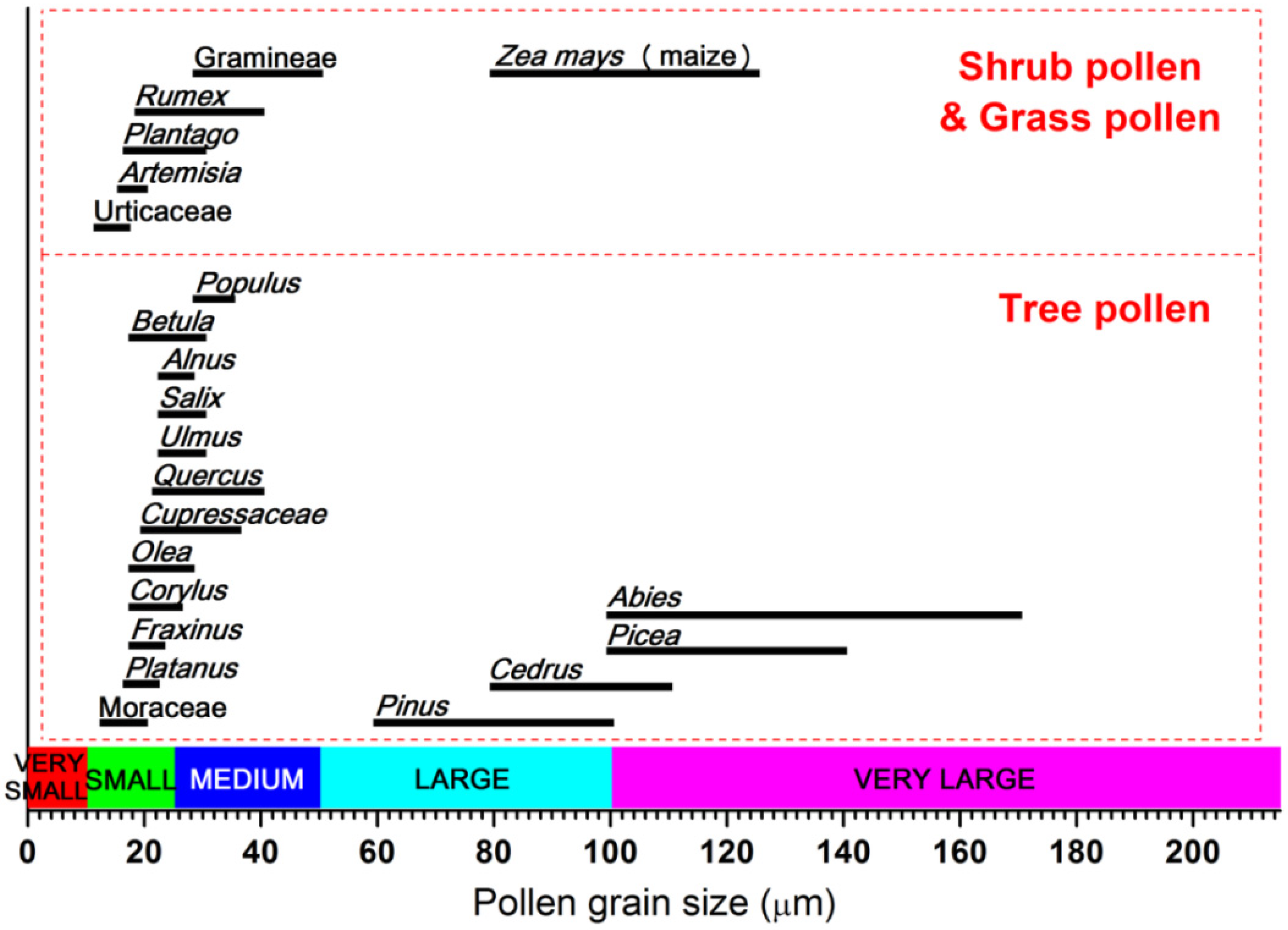
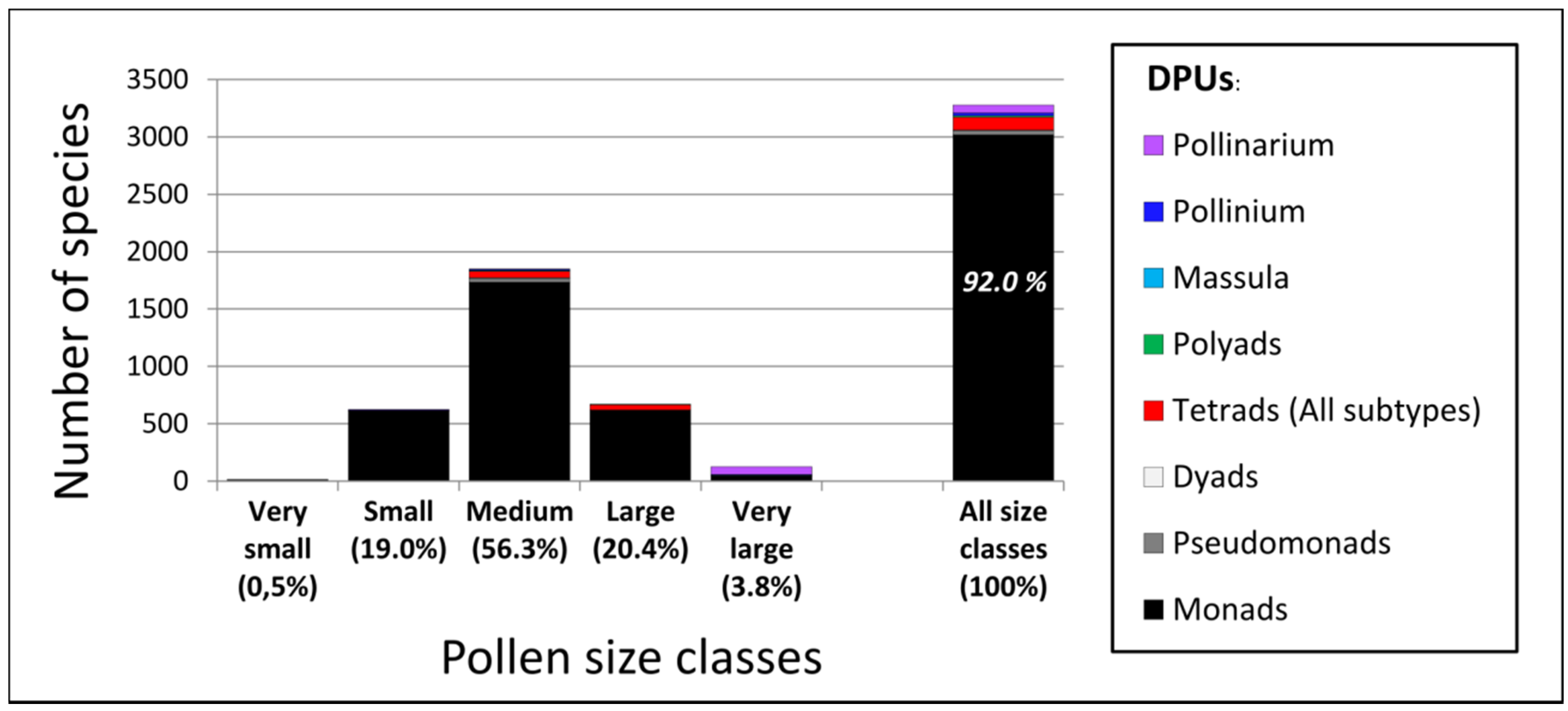

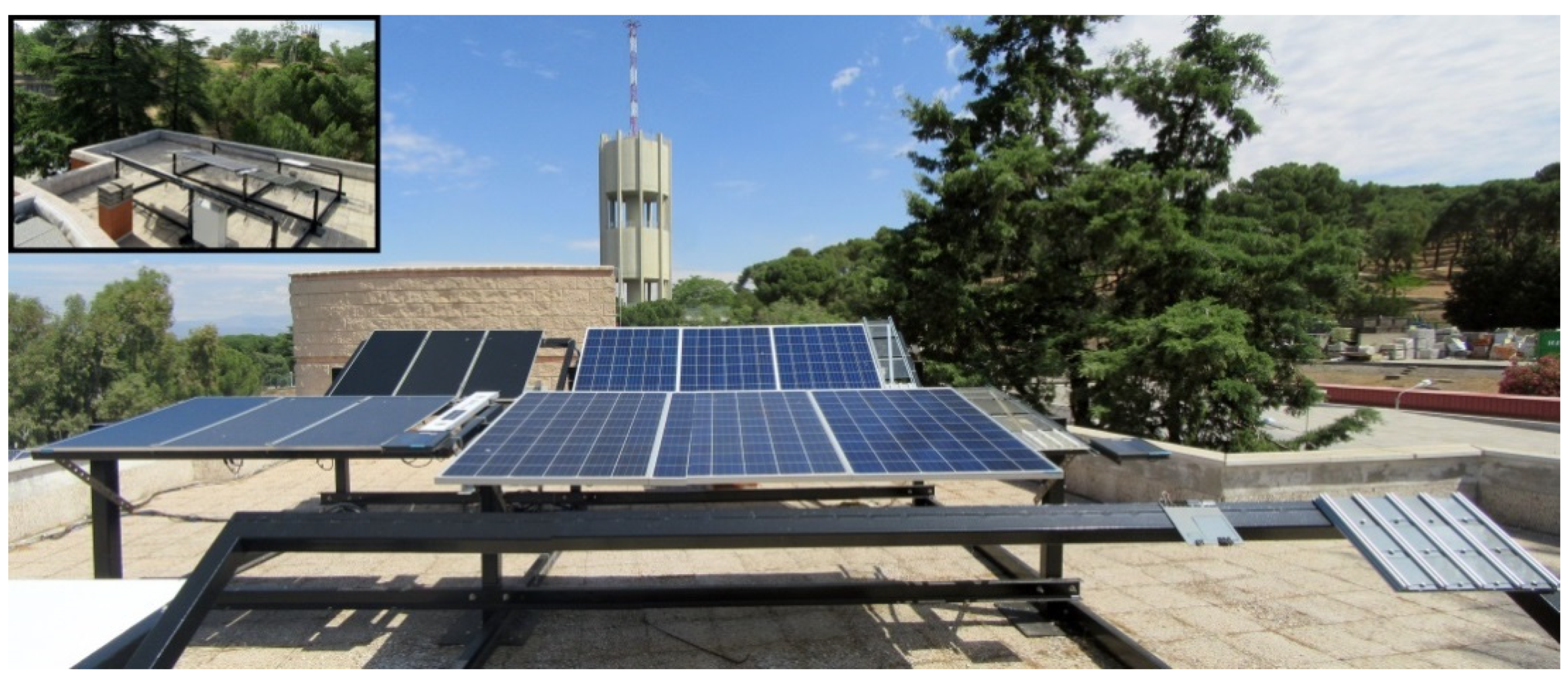
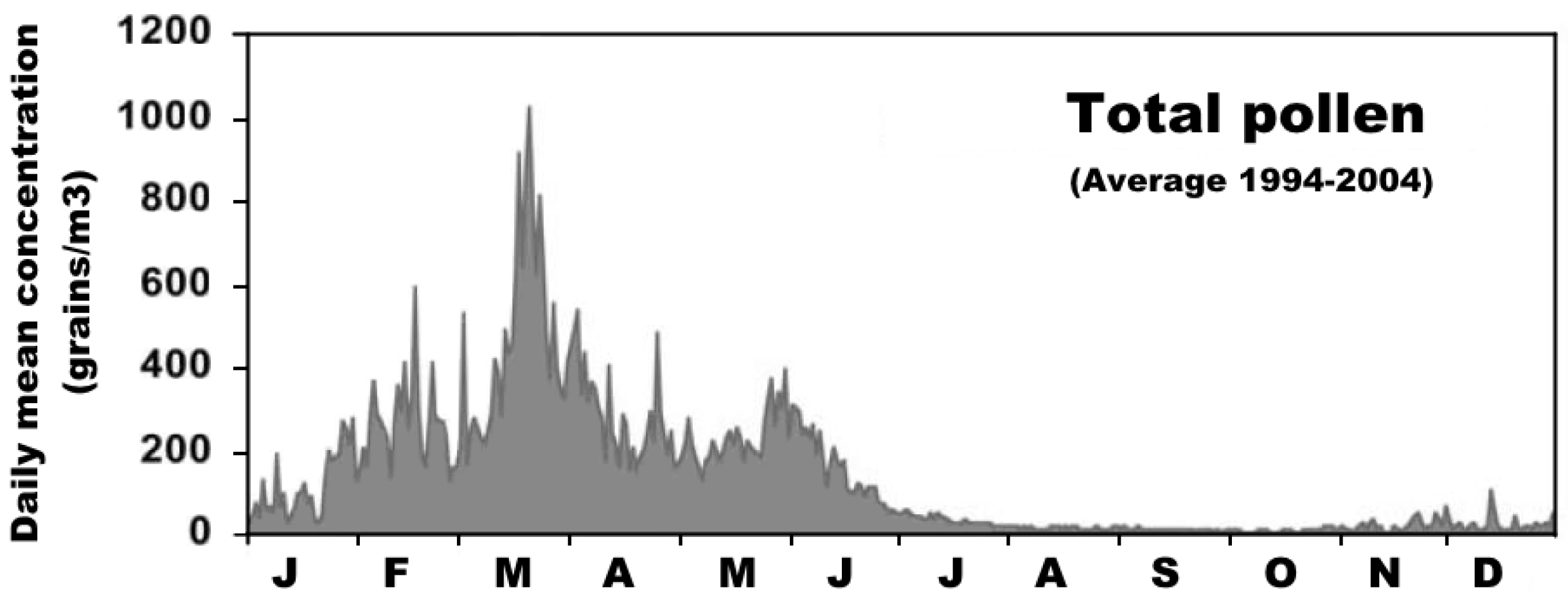
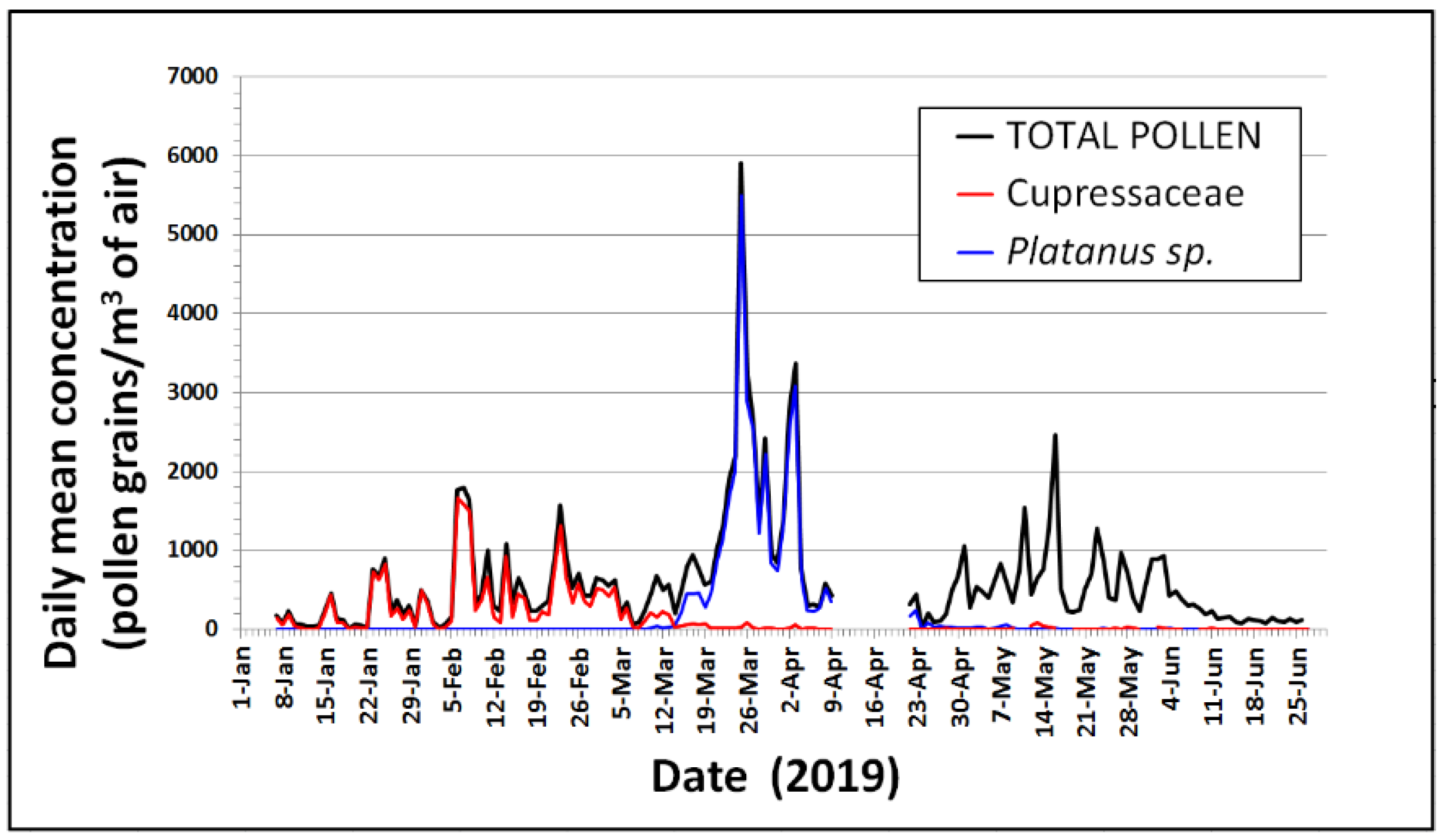
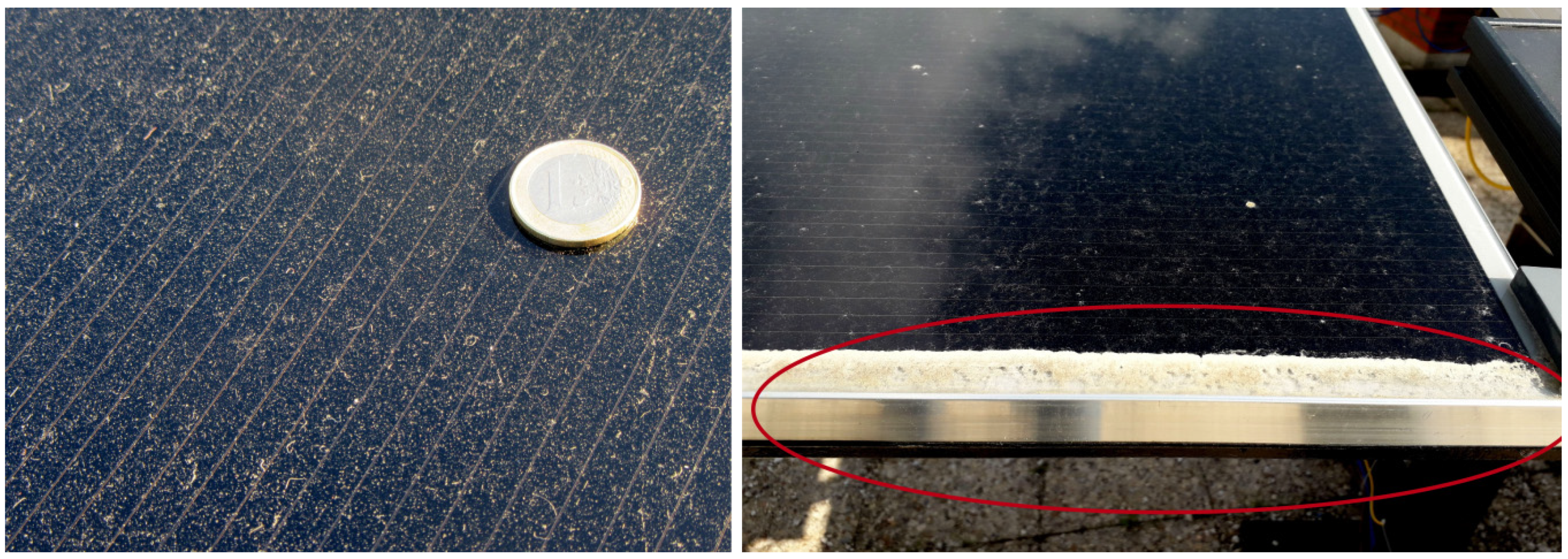
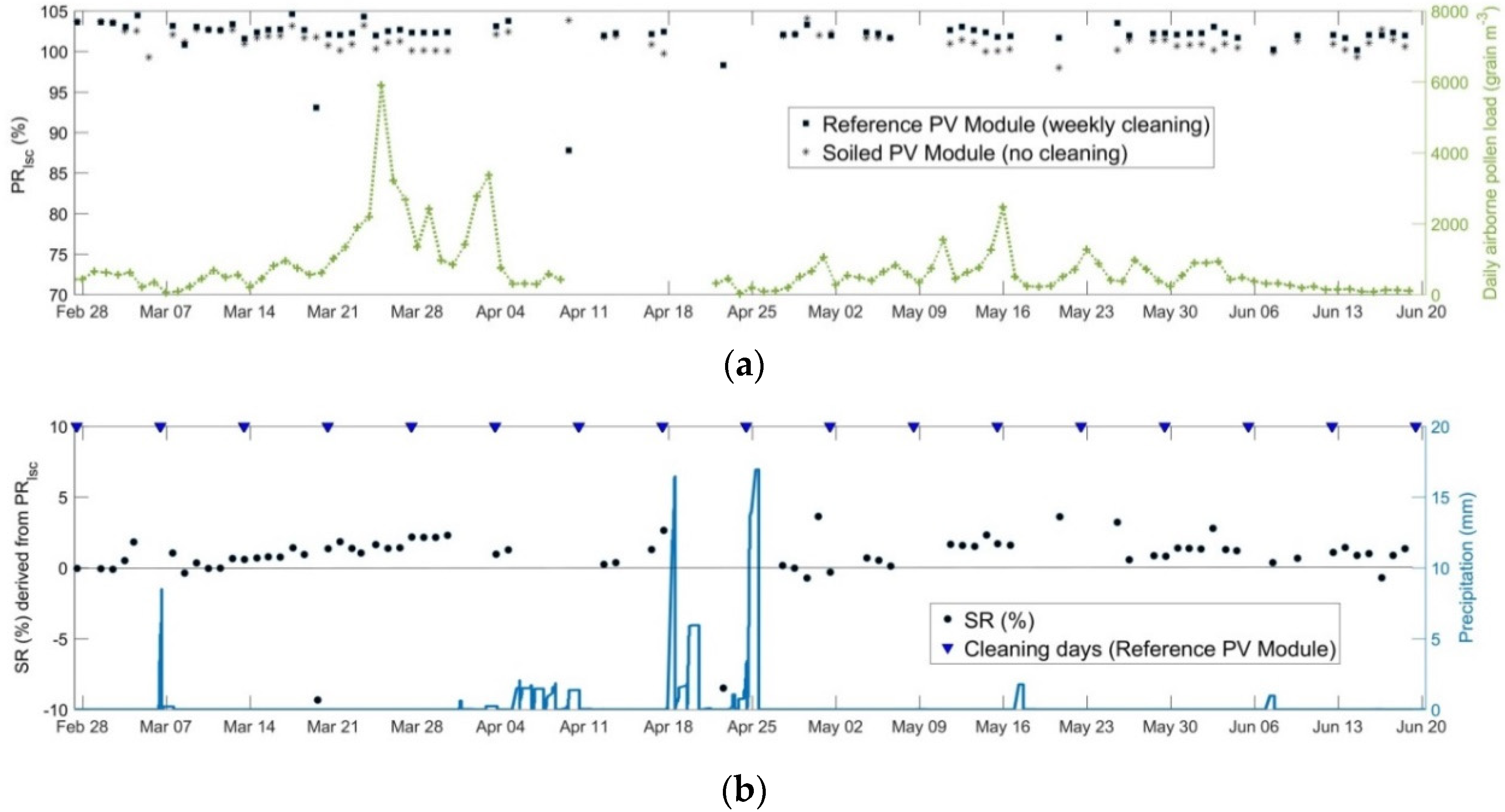

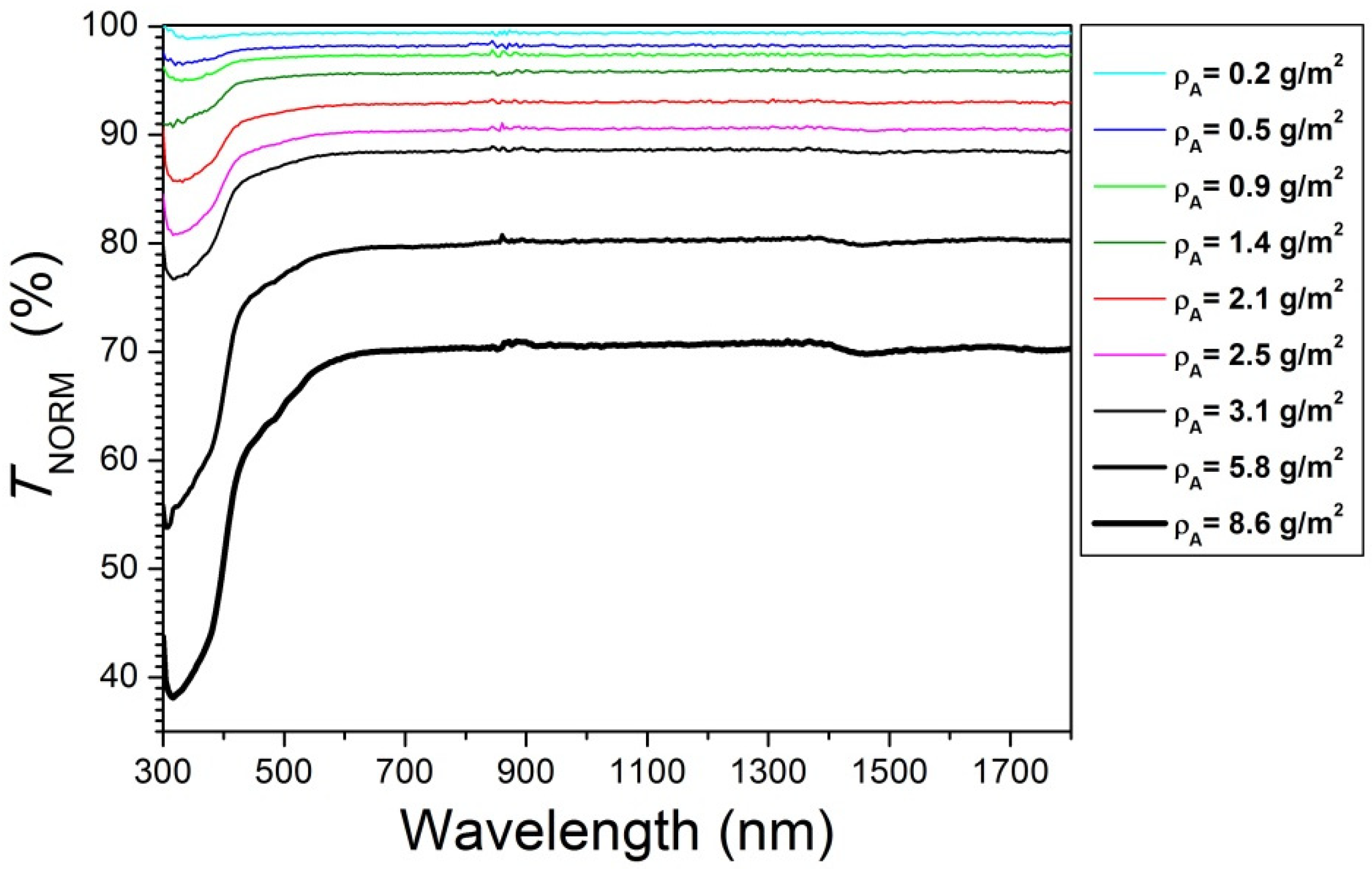

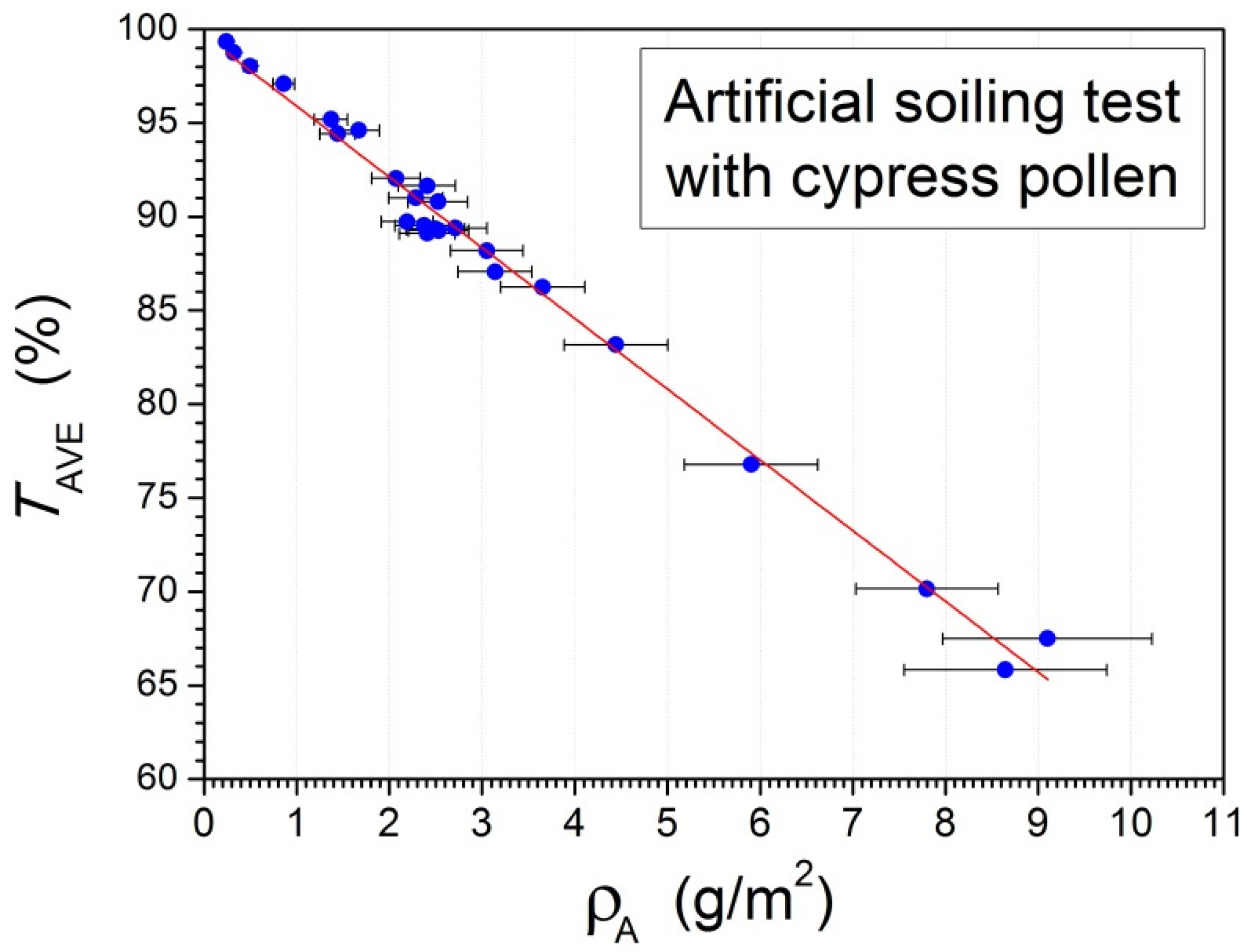
© 2020 by the authors. Licensee MDPI, Basel, Switzerland. This article is an open access article distributed under the terms and conditions of the Creative Commons Attribution (CC BY) license (http://creativecommons.org/licenses/by/4.0/).
Share and Cite
Sanz Saiz, C.; Polo Martínez, J.; Martín Chivelet, N. Influence of Pollen on Solar Photovoltaic Energy: Literature Review and Experimental Testing with Pollen. Appl. Sci. 2020, 10, 4733. https://doi.org/10.3390/app10144733
Sanz Saiz C, Polo Martínez J, Martín Chivelet N. Influence of Pollen on Solar Photovoltaic Energy: Literature Review and Experimental Testing with Pollen. Applied Sciences. 2020; 10(14):4733. https://doi.org/10.3390/app10144733
Chicago/Turabian StyleSanz Saiz, Carlos, Jesús Polo Martínez, and Nuria Martín Chivelet. 2020. "Influence of Pollen on Solar Photovoltaic Energy: Literature Review and Experimental Testing with Pollen" Applied Sciences 10, no. 14: 4733. https://doi.org/10.3390/app10144733
APA StyleSanz Saiz, C., Polo Martínez, J., & Martín Chivelet, N. (2020). Influence of Pollen on Solar Photovoltaic Energy: Literature Review and Experimental Testing with Pollen. Applied Sciences, 10(14), 4733. https://doi.org/10.3390/app10144733





